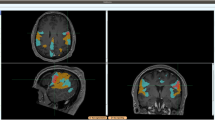Abstract
Purpose
To constrain the risk of severe toxicity in radiotherapy and radiosurgery, precise volume delineation of organs at risk is required. This task is still manually performed, which is time-consuming and prone to observer variability. To address these issues, and as alternative to atlas-based segmentation methods, machine learning techniques, such as support vector machines (SVM), have been recently presented to segment subcortical structures on magnetic resonance images (MRI).
Methods
SVM is proposed to segment the brainstem on MRI in multicenter brain cancer context. A dataset composed by 14 adult brain MRI scans is used to evaluate its performance. In addition to spatial and probabilistic information, five different image intensity values (IIVs) configurations are evaluated as features to train the SVM classifier. Segmentation accuracy is evaluated by computing the Dice similarity coefficient (DSC), absolute volumes difference (AVD) and percentage volume difference between automatic and manual contours.
Results
Mean DSC for all proposed IIVs configurations ranged from 0.89 to 0.90. Mean AVD values were below \(1.5\,\hbox {cm}^{3}\), where the value for best performing IIVs configuration was \(0.85\,\hbox {cm}^{3}\), representing an absolute mean difference of \(3.99\,\%\) with respect to the manual segmented volumes.
Conclusion
Results suggest consistent volume estimation and high spatial similarity with respect to expert delineations. The proposed approach outperformed presented methods to segment the brainstem, not only in volume similarity metrics, but also in segmentation time. Preliminary results showed that the approach might be promising for adoption in clinical use.







Similar content being viewed by others
References
Ferlay J, Soerjomataram I, Dikshit R, Eser S, Mathers C, Rebelo M, Parkin DM, Forman D, Bray F (2013) GLOBOCAN 2012 v1.0, cancer incidence and mortality worldwide: IARC CancerBase no. 11. Lyon, France: International Agency for Research on Cancer. http://globocan.iarc.fr. Accessed 16 Dec 2014
Cattaneo GM, Reni M, Rizzo G, Castellone P, Ceresoli GL, Cozzarini C, Ferreri AJ, Passoni P, Calandrino R (2005) Target delineation in post-operative radiotherapy of brain gliomas: interobserver variability and impact of image registration of MR (pre-operative) images on treatment planning CT scans. Radiother Oncol 75(2):217–223
Dolz J, Massoptier L, Vermandel M (2015) Segmentation algorithms of subcortical brain structures on MRI for radiotherapy and radiosurgery: a survey. IRBM. doi:10.1016/j.irbm.2015.06.001
Babalola KO, Patenaude B, Aljabar P, Schnabel J, Kennedy D, Crum W, Smith S, Cootes T, Jenkinson M, Rueckert D (2009) An evaluation of four automatic methods of segmenting the subcortical structures in the brain. Neuroimage 47(4):1435–1447
Bondiau PY, Malandain G, Chanalet S, Marcy PY, Habrand JL, Fauchon F, Paquis P, Courdi A, Commowick O, Rutten I, Ayache N (2005) Atlas-based automatic segmentation of MR images: validation study on the brainstem in radiotherapy context. Int J Radiat Oncol Biol Phys 61:289–298
Isambert A, Dhermain F, Bidault F, Commowick O, Bondiau PY, Malandain G, Lefkopoulos D (2008) Evaluation of an atlas-based automatic segmentation software for the delineation of brain organs at risk in a radiation therapy clinical context. Radiother Oncol 87:93–99
Toga AW, Thompson PM (2001) The role of image registration in brain mapping. Image Vis Comput 19:3–24
Lee JD, Tseng YX, Liu LC, Huang CH (2007) A 2-D automatic segmentation scheme for brainstem and cerebellum regions in brain MR imaging. In: Conference proceeding on fuzzy systems and knowledge discovery, vol 4. pp 270–274
Moghaddam MJ, Soltanian-Zadeh H (2009) Automatic segmentation of brain structures using geometric moment invariants and artificial neural networks. In: Prince J, Pham D, Myers K (eds) Information processing in medical imaging. Lecture notes in computer science, vol 5636. Springer, Berlin, Heidelberg, pp 326–337
Kim EY, Johnson H (2010) Multi-structure segmentation of multi-modal brain images using artificial neural networks. In: SPIE medical imaging. International society for optics and photonics, pp 76234B–76234B
Magnotta VA, Heckel D, Andreasen NC, Cizadlo T, Corson PW, Ehrhardt JC, Yuh W (1999) Measurement of brain structures with artificial neural networks: two-and three-dimensional applications 1. Radiology 211(3):781–790
Powell S, Magnotta VA, Johnson H, Jammalamadaka VK, Pierson R, Andreasen NC (2008) Registration and machine learning-based automated segmentation of subcortical and cerebellar brain structures. Neuroimage 39(1):238–247
Burges C (1988) A tutorial on support vector machines for pattern recognition. Data Min Knowl Disc 2(2):121–167
Abdi MJ, Hosseini SM, Rezghi M (2012) A novel weighted support vector machine based on particle swarm optimization for gene selection and tumor classification. Comput Math Methods Med 2012. Article Id 320698
Chang CC, Lin CJ (2011) LIBSVM: a library for support vector machines. ACM Trans Intell Syst Tech 2:27:1–27:27
Dice LR (1945) Measures of the amount of ecologic association between species. Ecology 26(3):297–302
Acknowledgments
This project has received funding from the European Unions Seventh Framework Programme for research, technological development and demonstration under Grant Agreement No. PITN-GA-2011-290148.
Author information
Authors and Affiliations
Corresponding author
Ethics declarations
Conflict of interest
Jose Dolz, Solakhna Ken, Henri-Arthur Leroy, Nicolas Reyns, Anne Laprie, Laurent Massoptier and Maximilen Vermandel declare that they have no conflict of interest.
Ethical standard
All procedures followed were in accordance with the ethical standards of the responsible committee on human experimentation (institutional and national) and with the Helsinki Declaration of 1975, as revised in 2008 (5).
Informed consent
For this type of study, formal consent is not required.
Rights and permissions
About this article
Cite this article
Dolz, J., Laprie, A., Ken, S. et al. Supervised machine learning-based classification scheme to segment the brainstem on MRI in multicenter brain tumor treatment context. Int J CARS 11, 43–51 (2016). https://doi.org/10.1007/s11548-015-1266-2
Received:
Accepted:
Published:
Issue Date:
DOI: https://doi.org/10.1007/s11548-015-1266-2




